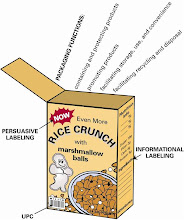What is a product you ask? Taken straight from the book "It’s the starting point in creating a marketing mix. It’s everything, both favorable and unfavorable that a person received in an exchange. A product may be tangible like a pair of shoes, a service like a haircut, an idea like “don’t litter," or any combination of these three. Packaging, style, color, option, and size are some typical product features. All just as important are intangibles such as service, the seller’s image, the manufacturer’s reputation, and the way consumers believe others will view the product."
I like convenience products, an inexpensive item that merits little shopping effort. I don’t often do a lot of planning so it’s nice to purchase a convenient product which is provided to those who don’t do the needed planning and are in need something right away. What's interesting is that a shopping product would be more expensive than a convenience product and is found in fewer stores. These are often the type of products that one would compare several brands or stores on style, practicality, price, and lifestyle compatibility. I love when specialty products are distributed to only one or very few outlets in a geographic area, makes it so inconvenient for us consumers when we’re looking for an item which we can’t get.
I often like to observe the way a package has been assembled. The three most important functions of packaging are to contain and protect products, promote products, and facilitate the storage, use, and convenience of products. I liked the example they gave in the book of the packaging decision on Barbie. Very interesting.
Warranties: My favorite...Why is it that most warranties are up when we have a problem? If a warranty confirms the quality or performance of a good or service then we should be assured that the product should work properly for some time right? Also, note that all sales have an implied warranty under the Uniform Commercial Code.
Christmas Eve
11 years ago



